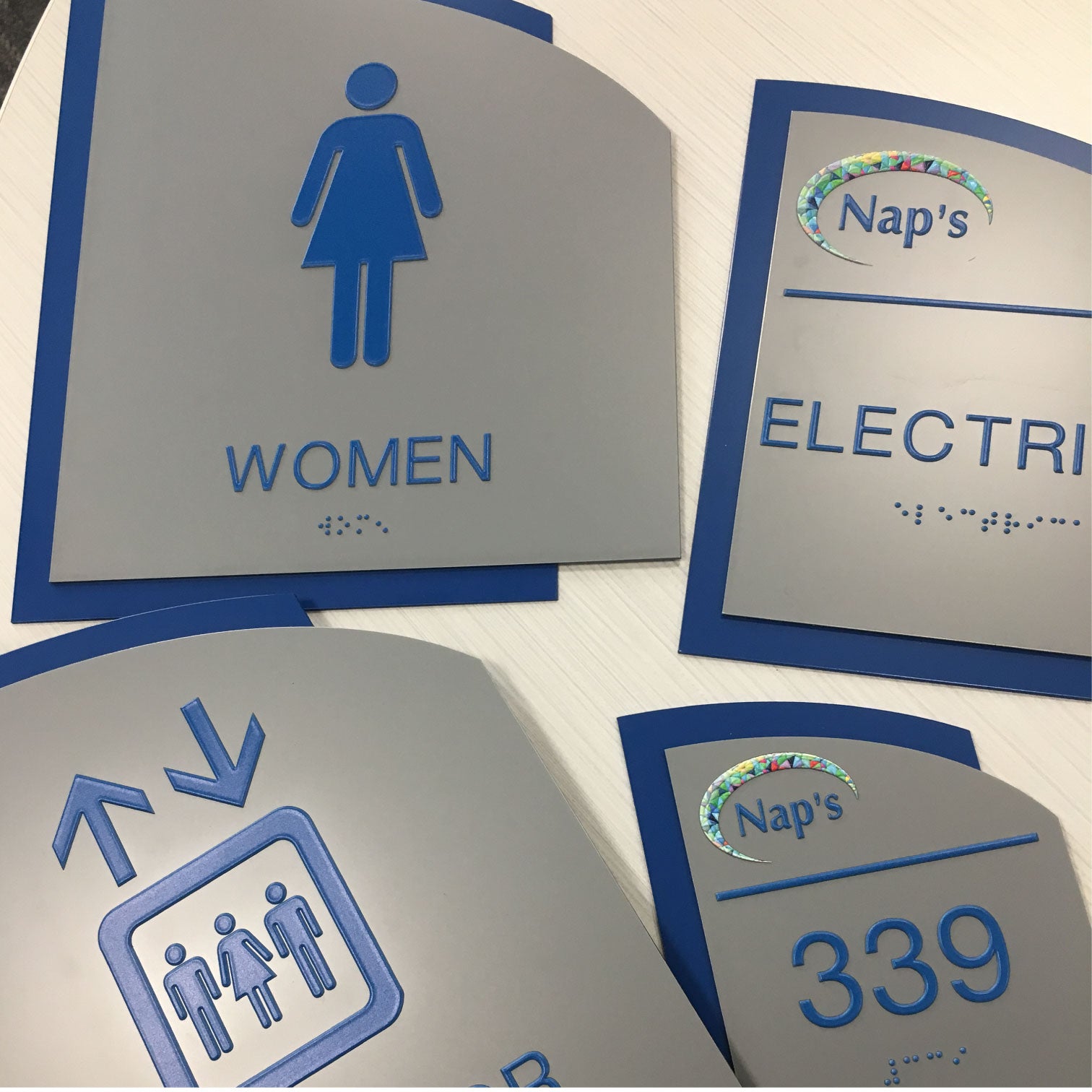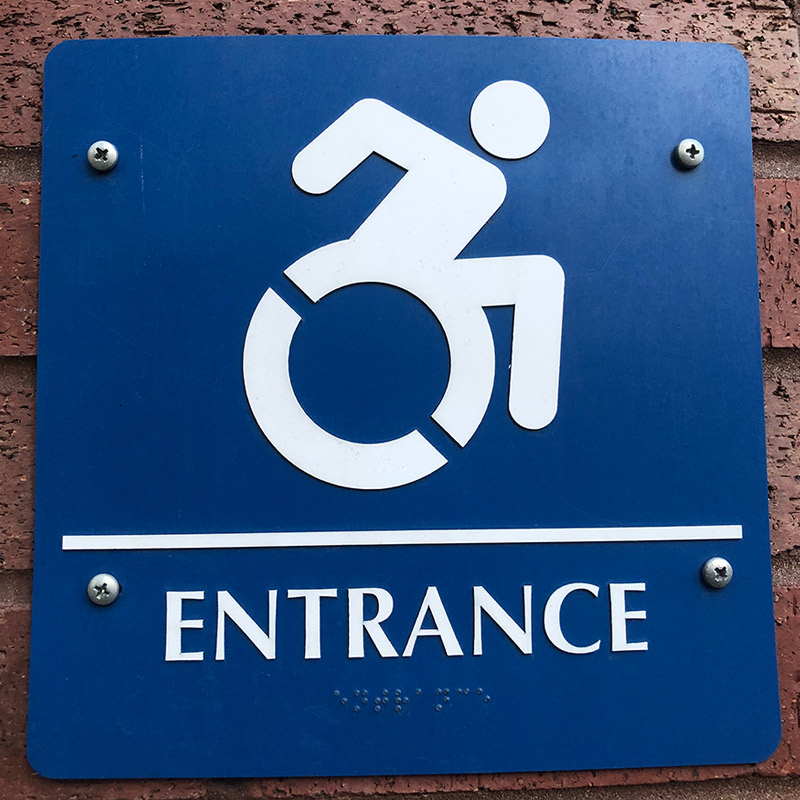Comprehending the Rules Behind ADA Signs
Comprehending the Rules Behind ADA Signs
Blog Article
Discovering the Trick Attributes of ADA Indicators for Improved Access
In the world of ease of access, ADA signs function as silent yet effective allies, guaranteeing that rooms are accessible and comprehensive for individuals with handicaps. By incorporating Braille and tactile elements, these indications break obstacles for the aesthetically damaged, while high-contrast color design and readable typefaces accommodate varied visual requirements. Their tactical positioning is not arbitrary however instead a calculated effort to promote seamless navigation. Past these functions lies a deeper narrative concerning the evolution of inclusivity and the ongoing commitment to creating equitable spaces. What more could these indications indicate in our pursuit of global accessibility?
Relevance of ADA Conformity
Making certain conformity with the Americans with Disabilities Act (ADA) is critical for promoting inclusivity and equivalent access in public rooms and workplaces. The ADA, enacted in 1990, mandates that all public centers, employers, and transport services accommodate individuals with disabilities, guaranteeing they delight in the exact same rights and opportunities as others. Conformity with ADA criteria not only fulfills legal responsibilities yet also boosts a company's credibility by demonstrating its dedication to diversity and inclusivity.
One of the vital aspects of ADA compliance is the application of accessible signage. ADA signs are made to ensure that people with impairments can easily navigate through rooms and structures.
Moreover, adhering to ADA policies can alleviate the threat of prospective penalties and legal consequences. Organizations that stop working to abide by ADA standards might face penalties or claims, which can be both harmful and monetarily difficult to their public photo. Thus, ADA compliance is integral to fostering an equitable environment for everyone.
Braille and Tactile Aspects
The unification of Braille and tactile elements right into ADA signage personifies the concepts of ease of access and inclusivity. It is generally put under the corresponding text on signs to guarantee that individuals can access the details without visual help.
Responsive aspects extend past Braille and consist of raised personalities and icons. These elements are designed to be noticeable by touch, allowing people to determine space numbers, restrooms, leaves, and other important locations. The ADA sets certain guidelines pertaining to the size, spacing, and positioning of these responsive elements to maximize readability and make certain uniformity throughout various atmospheres.

High-Contrast Color Systems
High-contrast color design play a pivotal role in improving the visibility and readability of ADA signs for individuals with visual problems. These plans are essential as they take full advantage of the difference in light reflectance between text and background, making certain that indicators are easily noticeable, even from a distance. The Americans with Disabilities Act (ADA) mandates making use of details shade contrasts to fit those with limited vision, making it an important facet of compliance.
The efficacy of high-contrast colors lies in their capability to attract attention in various illumination conditions, including dimly lit settings and locations with glow. Usually, dark message on a light history or light message on a dark history is employed to attain optimum comparison. Black text on a yellow or white history gives a plain visual distinction that aids in quick recognition and understanding.

Legible Fonts and Text Size
When considering the layout of ADA signage, the choice of understandable font styles and appropriate text dimension can not be overstated. The Americans with Disabilities Act (ADA) mandates that font styles must be sans-serif and not italic, oblique, script, extremely ornamental, or of unusual form.
The dimension of the message also plays a critical function in ease of access. According to ADA standards, the minimal message elevation need to be 5/8 inch, and it needs to enhance proportionally with viewing distance. This is particularly vital in public rooms where signage needs to be reviewed rapidly and precisely. Consistency in message size adds to a cohesive aesthetic experience, assisting people in browsing settings successfully.
In addition, spacing in between lines and letters is indispensable to legibility. Appropriate spacing stops personalities from showing up crowded, boosting readability. By adhering to these criteria, developers can substantially enhance availability, guaranteeing that signage offers its designated objective for all individuals, no matter of their aesthetic abilities.
Reliable Placement Strategies
Strategic placement of ADA signs is necessary for taking full advantage of ease of access and making sure conformity with lawful requirements. ADA standards stipulate that indications ought to be installed at an elevation between 48 to 60 inches from the ground to guarantee they are within the line of view for both standing and seated people.
Furthermore, signs have to be put surrounding to the lock side of doors to allow simple identification prior to entry. Uniformity in indicator positioning throughout a facility improves predictability, minimizing confusion and boosting overall individual experience.

Conclusion
ADA indications play an important function in advertising ease of access by integrating features that deal with the demands of people with handicaps. Integrating Braille and tactile read review aspects makes sure important details is easily accessible to the aesthetically impaired, while high-contrast color design and readable sans-serif typefaces boost visibility throughout various illumination conditions. Reliable placement strategies, such as ideal mounting heights and critical areas, further promote navigation. These components jointly foster an inclusive atmosphere, underscoring the significance of ADA compliance in ensuring equivalent gain access to for all.
In the realm of access, ADA indications serve as silent yet powerful allies, ensuring that areas are comprehensive and navigable for Continued individuals with impairments. The ADA, established in 1990, mandates that all public facilities, companies, and transportation solutions suit people with specials needs, guaranteeing they take pleasure in the very same legal rights and possibilities as others. ADA Signs. ADA indications are created to guarantee that individuals with specials needs can easily navigate with rooms and buildings. ADA standards specify that indicators ought to be installed at an elevation between 48 to 60 inches from the ground to guarantee they are within the line of view for both standing and seated people.ADA signs play an essential role in advertising availability by integrating features that address the requirements of people with specials needs
Report this page